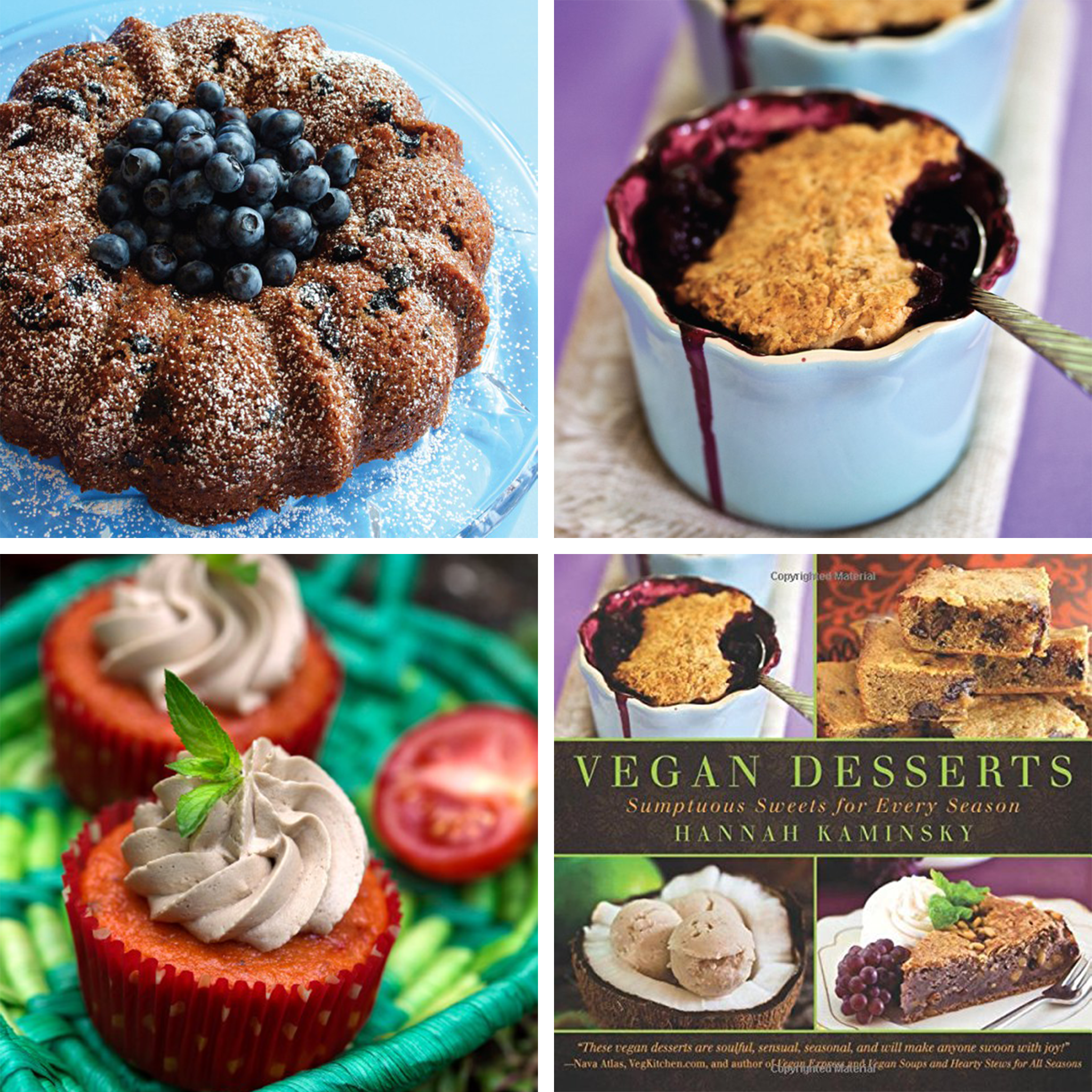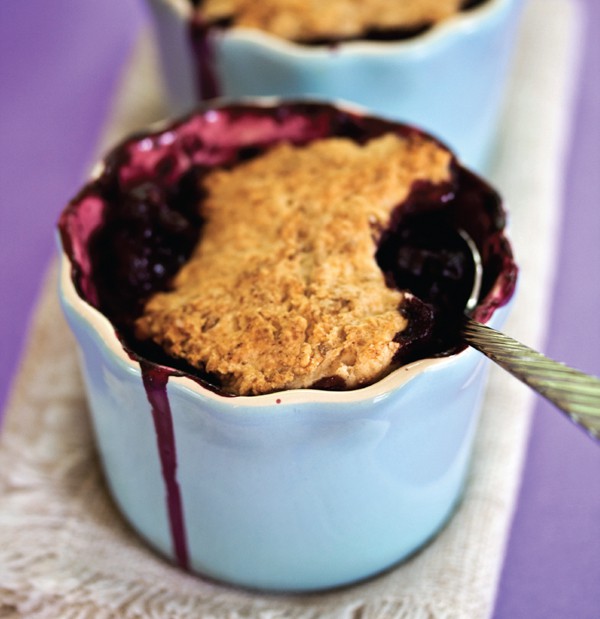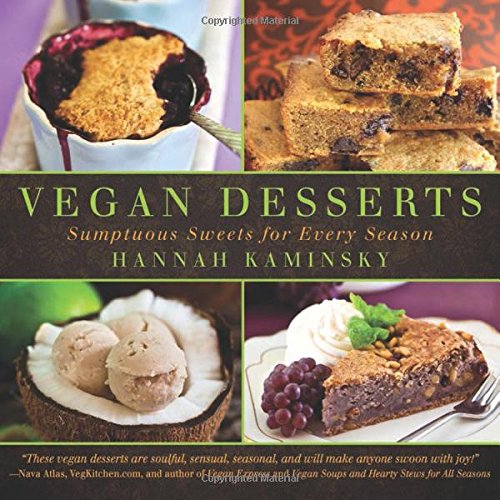Vegan Baking Basics
True Blue Bundt Cake, Tomato Cakes with Balsamic Frosting, and Cherry-Berry Peanut Butter Cobbler from Vegan Desserts
Vegan substitutions for butter, milk, and eggs
by Hannah Kaminsky
Butter, eggs, and milk—the staples of traditional desserts—no longer need apply when it comes to baking up the best treats. Tireless experimentation with vegan alternatives has come a long way in recent years, creating sweet delights that are not only as good as the traditional recipes, but often even better. The results may seem magical, but there are no tricky secrets to unveil here! A few simple swaps will reveal just how easy it is to bake completely plant-based delicacies.
When it comes to converting classic recipes, there are no hard and fast rules, just a few guidelines to help steer you in the right direction. It may take a bit of fine-tuning to get just the right combination, so don’t get frustrated if it’s not perfect on the first try. Here are just a few ideas to get you started:
Cherry-Berry Peanut Butter Cobbler from Vegan Desserts
To replace butter, the options available on the mainstream market have never been more abundant or more delicious. Some brands contain whey or other milk-derivatives, while others conceal the elusive, animal-derived Vitamin D3, so be alert when scanning ingredient labels. For ease, I prefer to use it in stick format, such as Earth Balance® Buttery Sticks or Miyoko’s Kitchen European Style Cultured VeganButter. Never try to substitute spreadable butter from a tub! These varieties have much more water to allow them to spread while cold, and will thus bake and cook differently.
Alternatively, if the recipe calls for melted butter, you can often substitute melted coconut oil at a 1:1 ratio. Just be careful to select refined coconut oil, as virgin coconut oil will impart a distinctive tropical taste.
To replace milk, an unlimited range of perfect replacements beck from the dairy aisle! Once limited to sour, beany soy, you can now choose from milks made of hemp seeds, oats, almonds, cashews, flaxseed, and more. They’re all mostly interchangeable when it comes to baking applications, as long as you opt for a variety that is unflavored and unsweetened. Rice milk is the only sort that doesn’t make the cut for me, personally, as it tends to be watery, and in the worst cases, gritty.
To recreate buttermilk, simply place 1 teaspoon apple cider vinegar in a 1 cup measuring scoop before filling the rest of the way with your non-dairy milk of choice. Stir gently to combine and let “curdle” for a few minutes before proceeding.
When it comes to cream or heavy cream, pure, full-fat coconut milk is the answer. Shake well and use it straight for ice cream, but if you want to make a light whipped topping, let the can chill in your fridge overnight. Scoop out the thick white cream on top and place it in the bowl of your stand mixer, leaving the clear water at the bottom. The water can't be whipped, but don't discard it; it's fantastic in smoothies, curries, and many other recipes! Beat the cream on high speed for about 5 - 8 minutes until fluffy. Sprinkle in a touch of sugar, if desired.
Tomato Cakes with Balsamic Frosting from Vegan Desserts
To replace eggs, the possibilities are vast, but the rational is a bit less straightforward. Bear in mind that the greater number of eggs you try to remove, the more difficult it will be to achieve consistent results. I would feel comfortable replacing up to three eggs in most recipes before needing to do more invasive structural rewiring for the rest of the formula. Bear in mind that the average medium egg is about 3 tablespoons in volume, whereas a large is closer to 4 tablespoons, so adjust accordingly.
My favorite eggless binder is aquafaba, the not-so-secret ingredient taking the world by storm, dubbed a “miracle” by some and a food science breakthrough by others. Believe it or not, it’s simply the excess liquid found in any ordinary can of chickpeas. Any bean can produce aquafaba, but the unique ratios of protein and starch found in garbanzo (chickpea) beans mimics the unique binding and whipping properties of egg whites. For more delicate applications like meringues or marshmallow fluff, you can always concentrate your aquafaba to create a stronger foam matrix by cooking it gently over the stove and reducing some of the water.
Otherwise, flaxseed or chia seed gel performs beautifully in most applications, particularly savory baked goods and breads. It takes a ratio of 3:1, water to ground seeds, mixed up and let sit for a few minutes to thicken. Make sure the seeds are ground very finely for the gel to be most effective, and least noticeable in the final texture.
Old-school alternatives include mashed banana, applesauce, and pumpkin puree, which work fine in heartier muffins and cakes, but inevitably contribute a denser texture and influence the overall flavor.
Rewrite your grocery lists, skip the animal products, and begin preheating your oven. Happy baking!
Hannah Kaminsky, author of My Sweet Vegan, Vegan a la Mode, Vegan Desserts, and Easy as Vegan Pie and creator of the award-winning blog BitterSweetBlog.com shares her top tips for vegan baking. Follow Hannah on Instagram, Twitter, Facebook.
Vegan Desserts is a featured title on ckbk
Hannah Kaminsky is a featured author on ckbk, home to the world's best cookbooks and recipes for all cooks and every appetite. Start exploring now ▸




